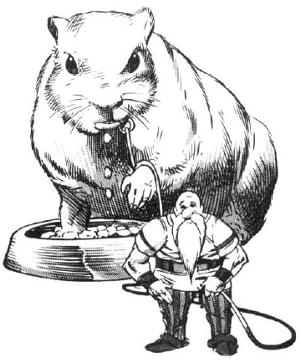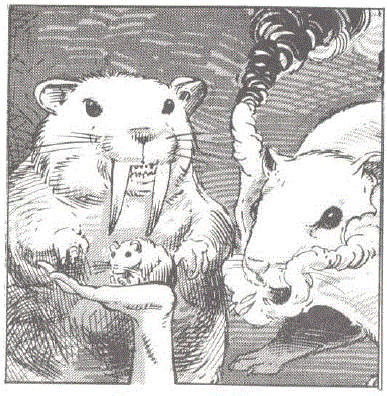
| Climate/Terrain: | Temperate/Grassy plains and hills |
|---|---|
| Frequency: | Common to very rare |
| Organization: | Small pack |
| Activity Cycle: | Night |
| Diet: | Omnivore |
| Intelligence: | Animal (1) |
| Treasure: | Nil |
| Alignment: | Neutral |
| No. Appearing: | See below |
| Armor Class: | 8 |
| Movement: | 9, Br 3 (hard earth) |
| Hit Dice: | 4 |
| THAC0: | 17 |
| No. of Attacks: | 1 |
| Damage/Attack: | 2-8 |
| Special Attacks: | Nil |
| Special Defenses: | Immune to disease |
| Magic Resistance: | Nil |
| Size: | L (up to 9' long) |
| Morale: | Unsteady (6) (if wild: Average (9)) |
| XP Value: | 175 |
Giant space hamsters are exactly what they sound like-cute but brown-bear-sized rodents with thick fur. They are found on worlds having colonies of Krynnish gnomes (gnomoi and minoi). Giant space hamsters come in a variety of colors, but are usually golden brown with white underbellies, bands, and spots. They are well muscled but appear fat. A giant space hamster can store up to 200 lbs. of food in its cheeks.
Combat: Giant space hamsters normally have only one mode of attack - a nasty bite. They avoid even this on most occasions, as domestic breeds are quite cowardly. However, wild breeds are more aggressive, and they briefly charge at anyone who approaches a burrow. Domesticated females profiting their litters also have improved morale (9). Careless gnome handlers have sometimes been bitten and (on a successful attack roll of 19 or better) stuffed into a cheek pouch, from which the gnome may escape if he rolls a successful Strength roll to open doors on a subsequent round. Trapped gnomes are merely covered in hamster spit, and are eventually spat out like old chewing gum when the hamster sees food.
Habitat/Society: A small pack of giant space hamsters consists of 1d4 adults (select the sexes by starting with a female and alienating thereafter, so a pack of three hamsters consists of two females and a male), with a 20% chance per adult female of 1d4 young being present (AC 10, MV 3, HD 1, #AT nil, Size S 3' long) and another 20% chance per adult female of 1d4 juvenile being present (AC 9, MV 6, HD 2, THAC0 19, #AT 1, Dmg 1d4, Size M 6' long). Gnomes are unable to figure out how to reduce their breeding rate, aside from seperating the sexes (this conclusion was suggested after a 22-year-long research program that included five gnome fatalities). Giant space hamsters can easily have several litters in one year, and they grow to breeding adulthood in but two years. These creatures live 18 years at most, and remain fertile all their adult lives.
Ecology: Giant space hamster easily fill the niche ocupied by large browsing animals, such as the elephant and the rhino on Earth, though most of them lack any real means of defending themselves. In the wild, they often die out despite their extraordinary reproductive rate. They are preyed upon by large- and medium-size carnivores, but they are immune to all parasites and diseases, magical or not. Cold weather forces them to hibernate for up to six months until the weather improves.
These creatures did not evolve naturally, as one might guess. They were created by a gnome research committee attempting to develop a relatively passive creature large enough to wind up the giant rubber bands attached to the huge running wheels inside gnomish spelljammer craft. These devices produce internal power from torque. (Teams of gnomes formerly filled this job.) The giant space hamsters produced by the committee ran for hours inside their big wheels, and were eventually spread through space.
Gnomes have found that the meat of giant space hamsters is quite tasty. Space hamster meat is called “spaham”, and many gnomes eat large quantities of spaham with every meal. Many hamster ranches simply breed giant space hamsters as livestock.
Variations
Possibly the worst aspect of the giant space hamster (aside from its ludicrous existence) is that enchanted substances from numerous other sorts of nonhuman monsters can be introduced into its reproductive processes, producing unbelievable (except to a gnome) new sorts of giant space hamsters. Some gnomish communities deliberately breed unique subspecies in competition with other communities to produce the most interesting varieties. Usually, the results are more or less like the normal sort of giant space hamster, such as the wooly, mottled, ochre. Oriental, Occidental, chartreuse, spotted, not-quite-so-spotted, only-a-littlespotted, plaid, cave-dwelling, three-toed, lesser, greater, greater lesser, lesser greater, albino, and flightless giant space hamsters. And then there are the really unusual varieties: such as the following:
* Subterranean Giant Space Hamster: This creature can dig through any material up to soft rock at MV 6; it attacks with its claws for 4d4/4d4.
* Sabre-toothed Giant Space Hamster: A nasty overbite lets this hamster attack for 2d8 points of damage with fangs (but it is still omnivorous).
* Rather Wild Giant Space Hamster: When confronted by nonhamsters, this one gains a morale of 19 and a +2 bonus to attack and damage rolls.
* Invisible Giant Space Hamster: This one can turn invisible at will once per day for 1d4 +4 turns, remaining invisible even if it attacks.
* Sylvan or Jungle Giant Space Hamster: This hamster can climb at MV 9 up any nonslick surface with a 99% chance of success.
* Miniature Giant Space Hamster: Being the same size as normal hamster (AC 10, MV 1, hp 1, etc.), this creature is often kept as a pet.
* Armor Plated Giant Space Hamster: Fur less and covered by a rhino-like hide (AC 3), this very aggressive (morale 16) critter is a hazard.
* Yellow Musk Giant Space Hamster: This yellow-furred hamster has a terrible odor. It emits a 30-foot-radius cloud of poisonous gas causing nausea (MV 3), blindness (-4 penalty to attack rolls), and weakness (reduce Strength by four levels) in anyone failing a saving throw vs. poison.
* Ethereal Giant Space Hamster: Not really ethereal, this one is translucent and its skeleton can be seen. The first sight of this beast produces fright, as per a scare spell.
* Carnivorous Flying Giant Space Hamster: A "regrettable if understandable line of inquiry" led to this bat-winged version (MV 9, Fl 24 (8); bites for 3d4 points of damage, two claws for 2d4 points of damage; Morale 15).
* Two-Headed Lernaean Bombardier Giant Space Hamster: "Well, we're certainly not likely to make this mistake again or al least not more than once again anyway: Each head can make a normal biting attack, it regenerates wounds at 3 hit points per round (but cannot regenerate lost body parts), and once per day it can belch so loudly that anyone within 30 feet must roll a successful saving throw vs. breath weapon or be stunned (unable to attack, defend, or move) for l d4 + I rounds.
* Fire-Breathing Phase Doppleganger Giant Space Hamster: "We completely fail to see why everyone is so upset, especially since biology is such an inexact science and for every step we take forward there must be two steps backward but anyway we said we were sorry and we'd like our funding back so we can pay our bail and go home:' This monster breathes a 30-foot-long cone of fire that is ten feet wide at its far end, three times per day for 3d8 points of damage (successful saving throw vs. dragon breath for half damage). The FBPDGSH suffers only half damage from fiery attacks. This species can also phase in and out of the Prime Material plane within a single round, just like a phase spider; it can do this up to six times per day with a -3 modifier to initiative. If this creature gains initiative by more than 4 points, it can breathe fire or bite, then phase out before being attacked. It can be attacked every round on the Ethereal plane with only a -1 modifier to its initiative. lt can also change its shape in one round to appear to be any other sort of bear-sized mammal. Worst of all, it is intelligent (5-7) and has a morale of 14, and it quickly learns how best to use its talents.
* Great Horned Giant Space Hamster: This one has a rhino-like horn on its nose, with which it inflicts 1d12 points of damage if charging more than 30 feet.
* Abominable Giant Space Hamster: An albino version adapted to arctic weather, this one feeds on conifers. It suffers only half damage from cold-based magic and no damage from nonmagical cold.
* Tyrannohamsterus Rex: This immense space hamster has absolutely no attacks whatsoever, unless it runs in fright and steps on someone (AC 2; MV 9; HD 16; THAC0 5; #AT 2; Dmg 10d10; MR 90%; Size 25' high at shoulder. weighs 75 tons; Morale 3). Any display of magic, fire, bright light, loud noise, etc., frightens this beast, which then crashes through all terrain features for 1d4 miles in its panic to escape, The now-defunct gnome colony that first bred this species did so "because it was there."
* Giant Space Hamster of Ill Omen: This possibly legendary creature is an individual rumored to be of unusual size, even larger than a Tyrannohamsterus Rex. "Wooly Rupert" (as he is known among gnomes) is also said to be highly intelligent and to possess spellcasting and spelljamming powers. Tales say he is not well disposed toward gnomes of any sort, preferring to squash them with his titanic paws. Gnomes everywhere fear the wrath of Wooly Rupert, though they laugh nervously and claim otherwise. Experience-point values for these and similar sorts of giant space hamsters should be awarded by the DM as he feels fit.
Experience-point values for these and similar sorts of giant space hamsters should be awarded by the OM as he feels fit.

